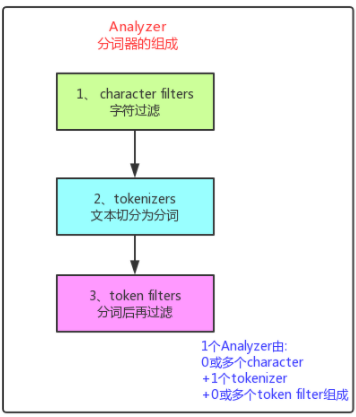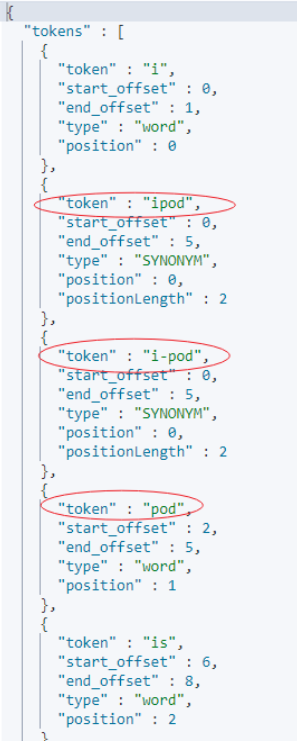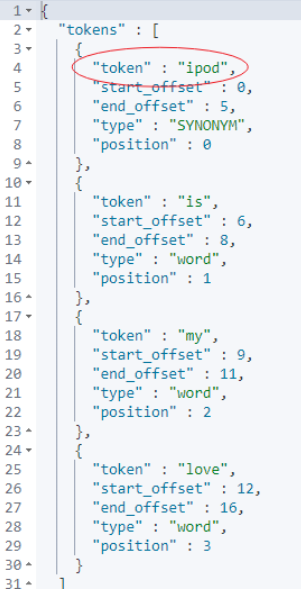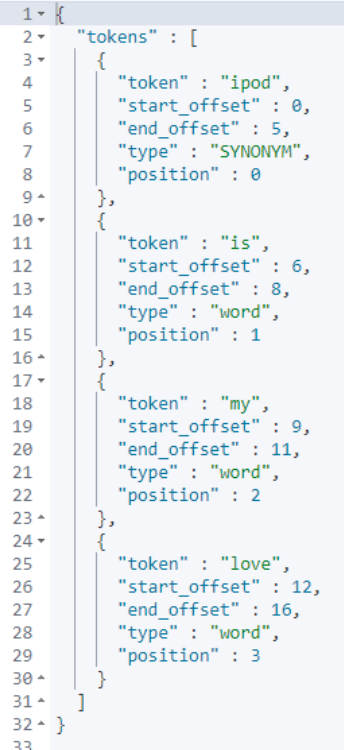Elasticsearch 自定义分词同义词环节的这个细节不大好理解......
1、问题引出
球友认证考试前一天晚上提问:

扩展背景描述:
这是 Elasticsearch 自定义分词 Text analysis 章节 Token filter reference 小节的 同义词 token 过滤 (Synonym token filter)的一个参数。
的确,官方文档讲解的不详细。
我们彻底解读一下。
2、自定义分词基础认知
如果读者们对自定义分词的实现有疑问,推荐阅读:
3、给个实战例子,一探究竟
3.1 自定义分词 DSL
PUT test_index
{
"settings": {
"index": {
"analysis": {
"analyzer": {
"synonym": {
"tokenizer": "whitespace",
"filter": [
"synonym"
]
}
},
"filter": {
"synonym": {
"type": "synonym",
"lenient": true,
"synonyms": [
"ipod, i-pod, i pod"
]
}
}
}
}
},
"mappings": {
"properties": {
"title": {
"type": "text",
"analyzer": "synonym"
}
}
}
}
解读如下:

如图所示,结合前面的 DSL 定义。
自定义分词器的名字:synonym。
tokenizer 使用:whitespace 空白分词器。
filter 也就是 token filter 使用:synonym 同义词实现。
而空白分隔分词器的本质,举例如下:
POST _analyze
{
"analyzer": "whitespace",
"text": "The 2 QUICK Brown-Foxes jumped over the lazy dog's bone."
}
分词后的结果为:
The |
2 |
QUICK |
Brown-Foxes |
jumped |
over |
the |
lazy |
dog's |
bone. |
概括一下:空格分词器在遇到空格字符时会将文本分解为多个词,仅以空格作为分词分隔单元。
3.2 token filter 细节参数解读
参数 1 —— "type": "synonym"
含义:同义词类型。
参数 2 ——"lenient": true
含义:如果为 true,则在解析同义词配置时会忽略异常。重要的是要注意,只有那些无法解析的同义词规则才被忽略。
默认值:false。
参数 3 —— "synonyms"
指定同义词,也就是指定谁和谁成为同义词。
参数4 ——“expand ”
这个就是文章开头提及的参数,缺省值就是 true。所以上述 DSL 并没有显示指定。
那参数:expand 到底啥意思呢?
4、通过对比,认清 expand 含义
4.1 验证 DSL
POST test_index/_doc/1
{"title":"ipod is my love"}
POST test_index/_doc/2
{"title":"i-pod is my love"}
POST test_index/_doc/3
{"title":"i pod is my love"}
POST test_index/_search
{
"query": {
"match": {
"title": "ipod"
}
}
}
POST test_index/_search
{
"query": {
"match": {
"title": "i-pod"
}
}
}
POST test_index/_search
{
"query": {
"match": {
"title": "i pod"
}
}
}
4.2 expand设置为 true
默认值,无需指定即可生效。
分词验证一把:
POST test_index/_analyze
{
"text":"i pod is my love",
"analyzer": "synonym"
}
结论截图如下:

执行 4.1 的 DSL,检索任何一个,全量三个文档都能返回。
ipod, i-pod, i pod 的含义如下:
具体意思:
ipod 等价于 ipod, i-pod, i pod 三个的每一个。
i-pod等价于 ipod, i-pod, i pod 三个的每一个。
i pod 等价于 ipod, i-pod, i pod 三个的每一个。
而,"ipod, i-pod, i pod => ipod"的含义如下:
POST test_index/_analyze
{
"text":"i pod is my love",
"analyzer": "synonym"
}

进一步解读为:
ipod 仅等价于 ipod,。
i-pod 仅等价于 ipod,。
i pod 仅等价于 ipod,。
4.3 expand设置为 false
DELETE test_index
PUT test_index
{
"settings": {
"index": {
"analysis": {
"analyzer": {
"synonym": {
"tokenizer": "whitespace",
"filter": [
"synonym"
]
}
},
"filter": {
"synonym": {
"type": "synonym",
"expand":false,
"lenient": true,
"synonyms": [
"ipod, i-pod, i pod"
]
}
}
}
}
},
"mappings": {
"properties": {
"title": {
"type": "text",
"analyzer": "synonym"
}
}
}
}
POST test_index/_analyze
{
"text":"i pod is my love",
"analyzer": "synonym"
}
POST test_index/_analyze
{
"text":"i-pod is my love",
"analyzer": "synonym"
}
上述最后两个 analyze 分词结果为:

ipod, i-pod, i pod 的含义如下:ipod, i-pod, i pod 和 ipod 等价。具体意思:
ipod 仅 等价于 ipod一个。
i-pod 仅 等价于 ipod一个。
i pod 仅 等价于 ipod一个。
"ipod, i-pod, i pod => ipod"的含义同 4.2 解读,不再赘述。
5、有了结论再看官方文档

expand 是扩展的意思。
如果为 true,支持扩展,和每一个同义词是同义词。
如果为 false,不支持扩展,仅和最后指向的同义词同义。
6、小结
实践一把,探究真相!
和你一起,死磕 Elastic!
Elastic 核心知识点脑图解读,助力快速建立全局知识体系!
推荐:
中国最大的 Elastic 非官方公众号
点击查看“阅读原文”,更短时间更快习得更多干货。和全球 1000 位+ Elastic 爱好者(含中国 50%+ Elastic 认证工程师)一起每日精进 ELK 技能!
